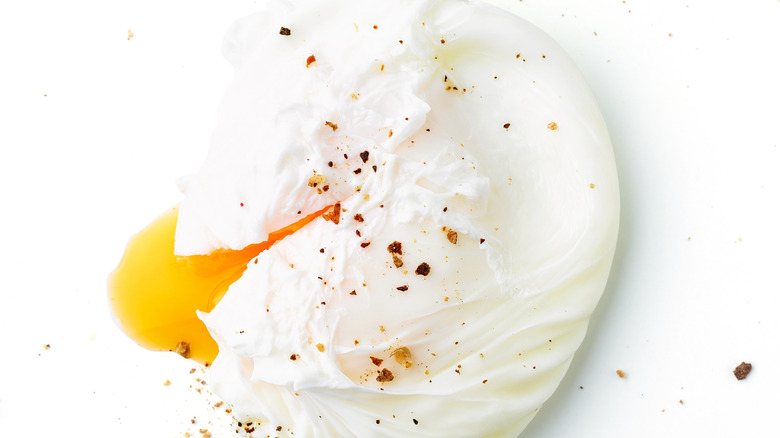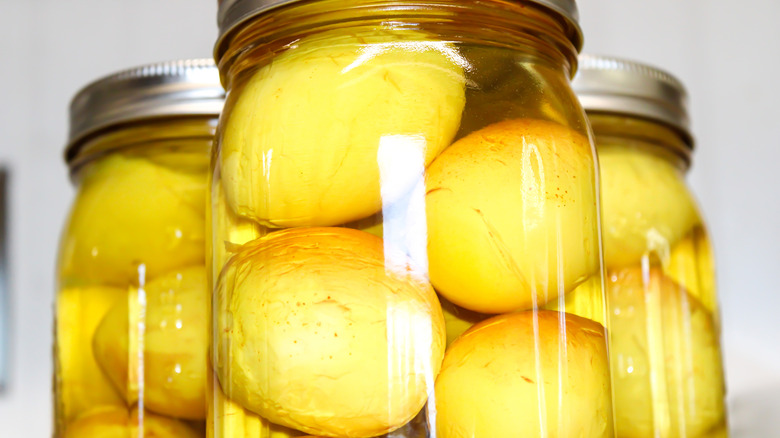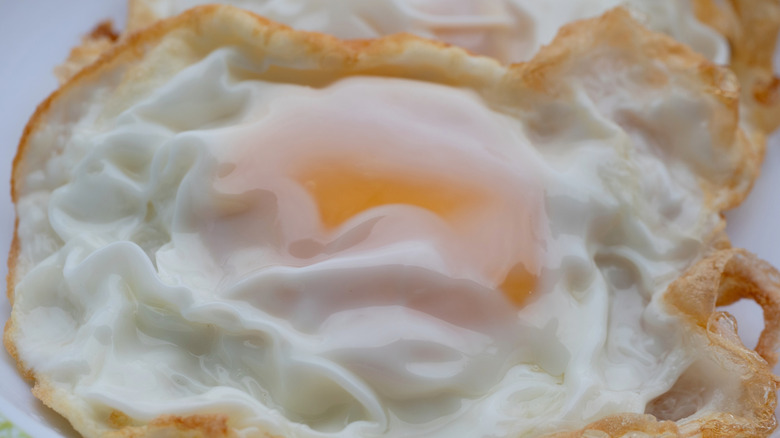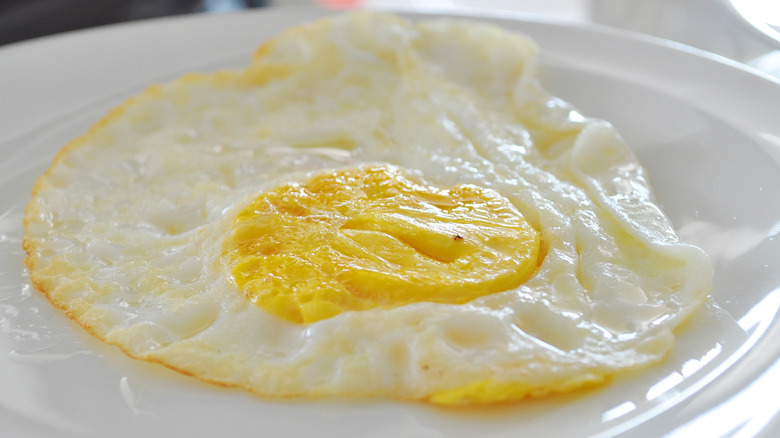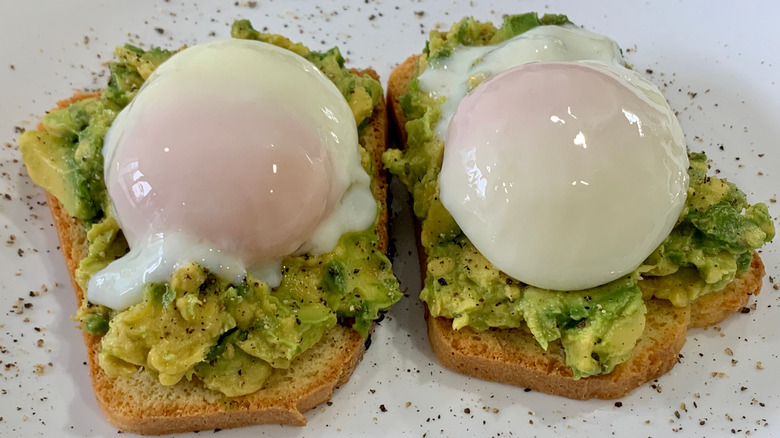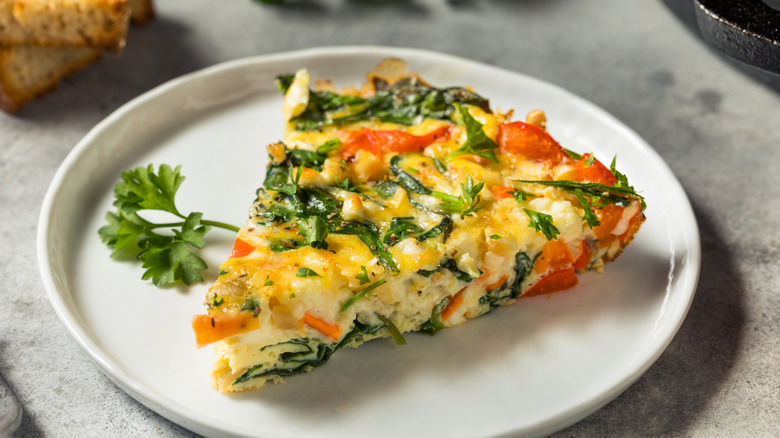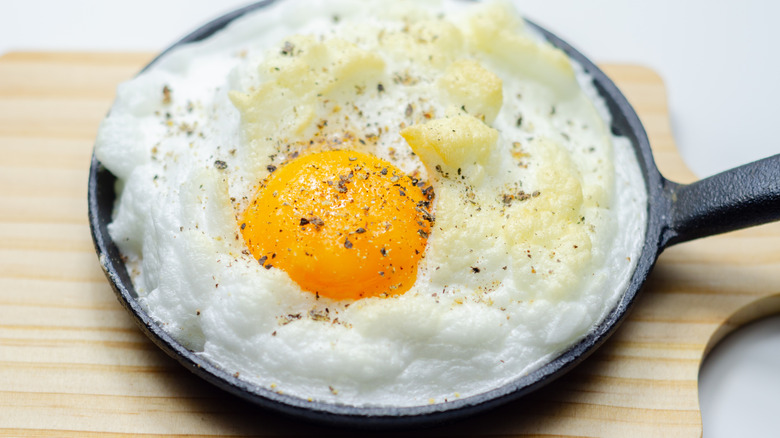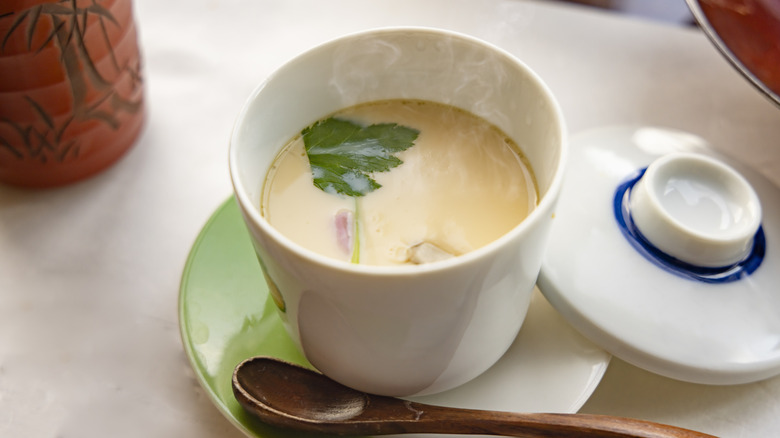19 Ways To Cook Eggs, Explained
We may receive a commission on purchases made from links.
Eggs are obviously one of the most popular breakfast orders at a diner. And the best thing about having eggs made to order is that you get to choose how you like your eggs made. While scrambled eggs may be America's favorite way to eat them, there are more ways to cook eggs than just scrambled.
If you're not eating eggs, you should start. These nutritional powerhouses are filled with protein, fat, and vitamin D. You can eat up to one egg a day (six to seven per week) without seeing negative health complications. Many of the negative misconceptions surrounding eggs are associated with the other cholesterol-rich breakfast foods served along with eggs (sorry, bacon).
Here are a number of different ways to cook eggs at home. And if you order one type of egg at a diner and receive a puzzled glare from your server, you might have an opportunity to share some egg-cellent information.
1. Hard-scrambled
Hard-scrambled eggs are made by heating broken eggs in a pan. There is little distinction between the yolk and the white with scrambled eggs, compared to a fried egg or a sunny-side-up egg. Since the eggs are scrambled together, the entirety of the egg is evenly heated. You can customize your scrambled egg recipe by adding herbs, fresh vegetables, or your favorite blend of shredded cheese.
Hard-scrambled eggs are typically just referred to as scrambled eggs. But there is an important distinction between hard-scrambled eggs and soft-scrambled eggs. Hard-scrambled eggs, as the name implies, are drier than soft-scrambled eggs. Hard-scrambling cooks the eggs over medium heat rather than low heat. This small difference results in a drier egg texture. If you want spongy, dry eggs, leave the eggs in the pan until the eggs appear dry. This will create a more flaky texture to the eggs, which is desirable for some egg enthusiasts.
2. Soft-scrambled
Soft-scrambled eggs are fluffy, light, and the perfect complement to your favorite breakfast toast. Predictably, these eggs are softer than hard-scrambled eggs. If you want soft-scrambled eggs, you need to whisk the eggs together with a fork before adding the eggs to the pan. This will increase the amount of air in the eggs. It's also important to add seasoning when you whisk your eggs to ensure that your spices are thoroughly mixed and aerated as well.
Soft-scrambled eggs require lower heat than hard-scrambled eggs, and you'll need to diligently watch the eggs to ensure that they don't harden. Cooking the eggs in a wide pan also ensures more even heat distribution for a softer, fluffier result. You should be attentive and pull your eggs off the heat once they are starting to curdle into lumps. If you leave the eggs in the pan while you run off to do other things, you could easily cook them more than you intended to.
3. Hard-boiled
Hard-boiled eggs are a go-to for a high-protein snack and or an egg salad. To make this style of egg, you'll need to use older eggs. Older eggs are easier to peel after hard-boiling because the membrane is less sticky. When you have your eggs ready, bring a pot of water to boiling and add your eggs. Bring the temperature down to medium-high and cook the eggs for about 15 minutes.
The next step to preparing hard-boiled eggs is critical. Transfer the cooked eggs from the hot water into an ice bath. Adding hard-boiled eggs to an ice bath for 15 minutes stops the eggs from further cooking in the shells. An ice bath can also make the eggs easier to peel, which is good for when you want to jump right into making an egg salad sandwich for lunch. You can also store hard-boiled eggs in the refrigerator in the shell for about a week.
You don't have to just stick to just eating your hard-boiled eggs out-of-hand, either. Try crumbling up your eggs and adding them to your tuna salad for an extra dose of protein, or stick to some of the more traditional salad-based accompaniments, like Cobb salad or niçoise salad.
4. Soft-boiled
Soft-boiled eggs have a less-set yolk than hard-boiled eggs. To make soft-boiled eggs at home, you'll want to drop eggs straight into the water as soon as it's bubbling. The longer the eggs are cooked, the firmer the yolk will be. To make the perfect ooey-gooey soft-boiled egg, you'll only need to cook your egg in boiling water for about four to five minutes. Simmering the eggs, rather than boiling, can also result in a softer-boiled egg. Soft-boiled eggs should not surpass more than eight minutes on the stove — beyond that, you're trekking into hard-boiled egg territory.
Soft-boiled eggs can be eaten with a variety of cuisines and dishes. Our favorite way to serve soft-boiled eggs is atop a bowl of steaming ramen noodles. The salty and umami flavors of the broth play well on the fattiness of the yolk, as well as the freshness of a chopped scallion garnish. The next time you have a batch of soft-boiled eggs, consider adding them to your fresh bowl of homemade ramen. This creative way to cook eggs will spruce up your recipe and offer a unique textural contrast to the crunchy veggies and warm broth.
5. Poached
Poached eggs are unlike other preparation methods of eggs. When you make poached eggs at home, you have to be especially diligent not to crack the seal of the white when plunging the egg into boiling water, or else you'll end up with a watery white. We've got plenty of egg tips, but one of the biggest is bringing the water to the egg by pouring hot water from a tea kettle into a tempered bowl with the eggs. You can also create a whirlpool motion with a spoon in the pot to ensure the egg drops safely and gently into the pot.
Poached eggs can be served with a ton of different breakfast dishes, but some say that poached eggs should never be served on toast. This is because the steam from the poached egg or the residual cooking water can quickly make the toast soggy and unappetizing. It's generally recommended to serve toast adjacent to poached eggs instead — that way you can use the toast to soak up the delicious yolk on your plate. That being said, if you want to protect your poached egg from making contact with your crisp toast, consider mashing up a layer of avocado to protect it. Not only will this creamy spread accent the soft yolk, but it will also prevent the steaming egg from making contact with the bread and making your avocado toast soggy.
Shakshuka is one of the most unique ways to use poached eggs; this recipe allows you to cook the eggs directly in the tomato sauce — no additional pots, pans, or effort required. Each bite will be filled with the punchy flavor of fire-roasted tomatoes, fresh herbs, and, of course, that decadently soft egg yolk.
6. Pickled
When you think of pickling, you probably picture vegetables. But eggs actually are a relatively easy food to pickle, and the process results in a savory, acidic product that lasts much longer than the eggs you get from your grocery store. We recommend making a brine with white vinegar, sugar (stirred until dissolved), fennel seeds, garlic, and peppercorns.
To make pickled eggs at home, you'll first need to hard-boil the eggs for about ten minutes before letting the eggs sit in cool water to slow the cooking speed. Once the eggs are cooled, peel the eggs and place the set into a sterilized jar. Add fresh tarragon and thyme to the jar and cover all of the eggs with your brine. After the jar is sealed, you should store it in a dark place in your kitchen for at least a week before opening. This time allows the acid in the pickling liquid to both flavor and preserve the eggs.
7. Sunny-side-up
Sunny-side-up eggs are a classic ingredient for breakfasts, lunches, and dinners. This style of egg preparation boosts a firm white with a soft unctuous yolk. Although this type of egg might appear simple, it is incredibly difficult to get a soft yolk and fully cooked whites. Scientifically speaking, egg whites finish cooking at 180 degrees Fahrenheit while egg yolks are finished cooking at 130 degrees Fahrenheit. Fortunately, there's a simple way to ensure your sunny-side-up eggs cook evenly: using a lid.
You should cover your pan with a lid when cooking sunny-side-up eggs because it traps the steam in the pan from both above and below the egg. After the egg is almost done, remove it from the heat but leave the lid on the pan. The steam will cook the rest of the egg thoroughly. Serve your sunny-side-up egg over a rice bowl with vegetables or with your favorite breakfast foods.
Croque madame is one of the tastiest ways to use this style of eggs. This classic French sandwich is served with a sunny-side up egg on top of it — rather than inside of it. While this might seem like a silly, inverted breakfast sandwich, it's a much more fun way to enjoy a ham and cheese sandwich. Just make sure you pack your fork and knife, as biting through it tends to get messy.
8. Over-easy
Over-easy eggs resemble the texture of sunny-side-up eggs, except for one cooking difference. The over-easy egg is flipped to cover the yolk while the sunny-side up features an uncovered yolk. You'll find a very similar runny yolk inside both of these egg preparation methods. After the eggs are finished cooking on the first side, the eggs are quickly flipped and lightly cooked on the other.
If you don't want to mess with precarious cooking times, consider making over-easy eggs in the microwave. You'll want to start by microwaving a plate for about 15 seconds to stimulate the heat from the bottom of the pan. Then, microwave the egg on the plate for 45 seconds before gently flipping the egg to seal the sides. Sprinkle and season the eggs with your favorites — we recommend an everything bagel seasoning blend and freshly cracked pepper. Serve with toast or a bagel for the perfect breakfast montage.
9. Over-medium
Over-medium, as the name implies, are slightly more cooked than over-easy and less cooked than over-hard eggs. Once the egg is flipped in the pan, it cooks for about one to two minutes before being served. This additional time will leave the yolk creamy, but not overly runny. You'll find similar runniness between a seven-minute soft-boiled egg and the quintessential over-medium egg.
Over-medium eggs are perfect for folks who like things down the middle. Maybe you don't like the super-soft texture of an over-easy egg, or perhaps you can't stomach the rubberiness of an over-hard egg. When cooking an over-medium egg, it's important to use fresh eggs to prevent them from splitting once they hit the pan. Serve over-medium eggs in a breakfast sandwich. The yolk won't ruin the texture of the sandwich but will still result in a perfect runniness that's unique to other egg preparation methods.
10. Over-hard
Over-hard eggs may not be everyone's favorite, but this method is still a viable way to make a quick breakfast. The over-hard egg has a longer cooking time than over-easy or over-medium eggs, so the yolk will be much stiffer and less pliable when all is said and done. There is no runniness to over-hard eggs; the yolk resembles that of a hard-boiled egg. When the over-hard egg is served, it can be served cut in half to ensure the yolk is fully cooked.
Over-hard eggs are perfect for folks who don't like to feel the runniness of a soft egg on the tongue. Kids especially may appreciate over-hard eggs more than other gooey preparation methods. Eat an over-hard egg on a breakfast sandwich for a breakfast without the mess. You can also add an over-hard egg to a noodle or a rice bowl for an extra boost of protein.
11. Omelet
Omelets are one of the best ways to cook eggs for breakfast because they're easily customizable; add bacon, ham, onions, or your favorite cheese to make this recipe uniquely yours. To make an omelet, you'll need to whisk eggs together with a fork and add the eggs to a flat, wide-bottom pan. You'll know the omelet is ready for toppings and flipping when the bottom layer of the egg turns a shade of golden brown. Flip your omelet by gently inserting a spatula underneath one side and flipping it closed. Once the omelet is folded in half, it is ready to serve. Omelet recipes can be simple, but cooking it takes diligence — overcooking your omelet will undoubtedly end in a dry and unfavorable result.
If flipping the omelet makes you nervous (and rightfully so), consider purchasing an omelet pan. These pans are easy to flip — simply fill half of the pan with the egg mixture and when you plan to flip the omelet, close the lid and rotate the pan.
12. Sous vide
Sous vide eggs are made by placing eggs in a container and cooking them inside a sous vide machine. Sous vide works by cooking vacuum-sealed food in a water bath. The resulting cooking consistency produces even cooking through all parts of the egg and allows you to walk away from the sous vide while it's doing its job. You won't have to worry about undercooked whites or poorly-cooked yolks. And if you're wondering if sous vide is worth it, consider the other foods — like steak and fish — you can make in your sous vide.
One easy way to cook eggs in a sous vide is to use small Mason jars. Blitz the eggs in a blender, add in your favorite toppings, and place the Mason jars in the sous vide. After cooking for about 45 minutes, the eggs will be set and can be stored in your refrigerator for a few days.
13. Frittata
A frittata is a baked egg dish made in an oven-safe pan. Unlike a quiche, which has a separate crust, the frittata is held together by the crust formed while cooking on the heat of the baking dish. You can customize a frittata with whatever ingredients your heart desires — from ham to vegetables to hard cheese. When you're making a frittata at home, you'll need to use a lot of eggs. Our recipe for a spinach frittata uses upwards of 10 eggs and heavy cream for a ton of extra flavor and added layers of creaminess.
Once you add your desired toppings to the pan, you'll need to cook the frittata for upwards of 20 minutes. To test for doneness, take the frittata out and shake the pan. If the frittata jiggles, you'll need to slide it back in the oven for a few extra minutes. Serve your frittata with a side of breakfast potatoes or for a quick dinner idea.
14. Deviled
Deviled eggs aren't as scary as the food sounds. Deviled eggs originated in ancient Rome. The phrase "deviled" traced back to the 1700s when it was used to describe dishes that were highly seasoned with spices and other flavorings.
Although one of the first proto-deviled egg recipes from the 1200s was made with ground eggs, cilantro, onion juice, pepper, coriander, and fermented fish sauce, modern deviled egg recipes usually use mayonnaise or mustard as a binder. You can upgrade your deviled egg recipe by adding hot sauce, imitation crab meat, or tuna fish to your mashed egg yolks. You can also make festive Christmas deviled eggs by garnishing them with pomegranate seeds as well as parsley for a red and green flare. Around Easter, you can create dyed deviled eggs by submerging the yolks in colored water. The colored eggs will be the perfect hue for a dinner spread or a tailgate.
15. Baked eggs
If you're gearing up for a delicious brunch, make sure baked eggs are on the menu. To make baked eggs at home, add your whole eggs (careful not to shatter any yolks) to an oven-safe baking dish atop your desired toppings. Our skillet recipe uses leeks and spinach, but you can also substitute this with any type of vegetable, meat mixture, or even bread. From there, the eggs are baked until the whites are set, and the yolks are slightly runny.
Baked eggs are a very scaleable recipe that can be made in individual ramekins or a massive baking dish for a crowd. The trick with baking eggs is to avoid overcooking them; you'll want to pull them out of the oven before the yolks are set. For many egg enthusiasts, this means checking the oven constantly after the seven-minute mark. In addition, the pan for these eggs should be adequately greased to prevent sticking.
16. Steamed eggs
Steaming produces a textural difference that sets this egg cooking method apart from the similar boiled variety. This is because the eggs are kept slightly above the boiling water rather than being completely submerged. This allows the egg to make contact with high, consistent heat while simultaneously preventing overcooking. Steamed eggs' yolks tend to remain rich and creamy, while the white remains soft and decadent.
There is also a version of steamed eggs common in Asian cuisine. This recipe adds seasoned scrambled eggs with a splash of water. The eggs are stirred (to add extra bubbles) and steamed once the lid has been secured. Once the lid is removed, a beautiful, soft custard is revealed. This custard is often eaten as an accompaniment to rice and meat dishes or as an appetizer for meals. Some families will also prepare this egg custard for babies because it is nutrient-dense and soft.
17. Cloud eggs
Cloud eggs are just as light and as fluffy as they sound. This unique way to cook eggs, which is otherwise called egg nests, is made by first separating the whites from the yolk. The raw egg whites are beaten in a stand mixer or with an electric beater until stiff peaks form, not unlike the process of making meringue (sans the sugar), before savory ingredients, like cheese, are added. Once the egg whites have been flavored and adequately whipped, they can be transferred to a lined baking sheet (or a skillet). In order to get the "nest" effect, the cook must make a small indentation to deposit the egg yolk in, before the eggs can be baked off in the oven.
If you're trying this recipe at home, you'll also want to refrain from adding the yolk until the whites have cooked enough. The result is a fluffy, yet sturdy, egg base and a silky-smooth yolk. Cloud eggs are a pleasing breakfast among kids (because who wouldn't want to eat a cloud?), but you can also give them a more adult flavor by adding in cheese or extra seasonings.
18. Periodic eggs
Although its name may suggest otherwise, "periodic eggs" refers more to a method of cooking eggs rather than a dish itself. The method, which is based off research published in Communications Engineering, is centered around the idea that the yolk and the whites cook at two different rates. Moving the egg between boiling and warm water every two minutes will perfectly cook it, as the process keeps the yolks at the sweet spot of 67 degrees Celsius (152.6 degrees Fahrenheit) and the whites between 35 degrees Celsius and 100 degrees Celsius (95 degrees Fahrenheit to 212 degrees Fahrenheit).
If this method of cooking eggs sounds laborious and time-consuming, that's because it is. All in all, it will take about 32 minutes to cook an egg using this method — which is far from the quick scramble that many of us love. But, proponents of this method explain that it yields the perfect egg, with a slightly firmer white than would be achieved via sous vide.
19. Chwanmushi
One of the foods that you absolutely have to try if you travel to Japan is chawan mushi (also spelled chawanmushi). This egg custard is made with simple, savory, and umami-rich ingredients, including dashi, soy sauce, mirin, salt, and eggs, and can be flavored with mushrooms, or proteins like shrimp or chicken. The beaten eggs are mixed together with the custard ingredients before being run through a cheesecloth to remove any lumps. The proteins and/or mushrooms are then added to the bottom of the dish and topped with the strained egg mixture. From there, the custard is covered and transferred to a steamer so that it can set. Chawanmushi can be enjoyed hot or cold and has a much more gelatinous consistency than other custards, like crème brûlée or flan.
There are some similarities between Japanese chawanmushi and Chinese egg custard, though the process for making them differs. The Japanese custard has to be run through a cloth, and it tends to have more liquid additions than the firmer Chinese variety, resulting in an egg custard that's truly jiggly.





